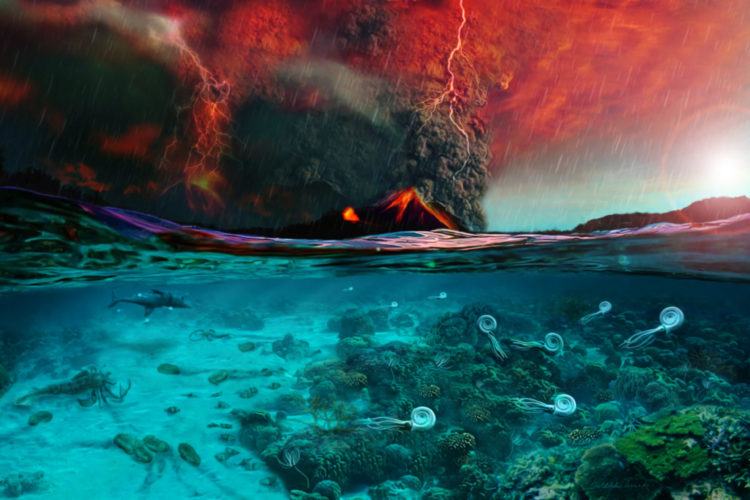2.52亿年前大灭绝 地球用了1000多万年才“活”过来
文 / 许禄艺
4/16/2021

(早报讯)2.52亿年前的二叠纪末期大灭绝之后,陆地生态系统花费多长时间才恢复?陆地生物又是如何恢复的?近日,中国地质大学(武汉)团队联合有关国际研究团队首次利用数学模拟等技术研究发现,大灭绝之后的陆地生态系统耗时1000多万年才得以恢复。新研究还揭示了该阶段的生物复苏过程。
新华社记者近日从中国地质大学(武汉)陈中强教授团队了解到,研究团队发现,2.52亿年前的大灭绝比其他灭绝事件对陆地生态系统更具破坏性,几乎每20个物种中就有19个灭绝,仅有5%的物种存活下来,生态系统需要重新建立。
“大灭绝后,少数高级消费者和生态系统底层的微生物等幸存了下来。比如二齿兽,在此后一段时间里一统江湖,成为陆地之王。”陈中强解释,“但是食物链中间环节的断裂和残缺,使得地球陆地生态系统非常脆弱,难以承受恶劣环境带来的毁灭性打击,以至于地球要花上1000多万年的时间来慢慢恢复往日的生机。”
陈中强介绍,团队首次运用生态系统数学模拟技术,运用计算机编程技术和计算系统,针对产自中国新疆地区二叠系-三叠系地层中数万多条化石记录信息,进行大数据分析。
“通过系统研究生物化石保存的形态功能特征、牙齿、胃容物和粪便化石,可以知道不同生物之间的捕食关系。”陈中强解释,把古食物链金字塔分为初级生产者、初级消费者、次级乃至高级消费者等关系,就像人们熟悉的大鱼吃小鱼,小鱼吃虾米。
研究中的古食物网由植物、软体动物、生活在湖泊中的昆虫、鱼类、两栖类和四足动物构成。这些四足动物小到蜥蜴类、大到巨型植食性动物,其中也包含掠食者。当这些动物灭绝后,接下来的1000多万年间,没有生物接替它们的位置,从而形成了极不稳定、脆弱的陆地生态系统。此后,恐龙和哺乳动物在三叠纪晚期开始出现。
“在此之前,我们可以描述古食物网,但很难定量测试它们的稳定性。”陈中强说,对古食物网的深入研究或将为未来的生态系统管理提供启示。
Great Dying – what caused Earth’s biggest mass extinction?
Monday 19 October 2020

New research led by the University of St Andrews and renowned German research centres helps answer one of the most asked questions in geoscience: what exactly caused the Earth’s biggest mass extinction?
Approximately 252 million years ago, long before the emergence of dinosaurs, at the Permian-Triassic boundary, the largest of the known mass extinctions on Earth occurred. With more than 95% of marine species becoming extinct, life in Permian seas, once a thriving and diverse ecosystem, was wiped out within only tens of thousands of years, a geological blink of an eye. This is now referred to as the ‘Great Dying’, a period when life on Earth has never been so close to becoming extinct.
Scientists have long debated the theories of the cause of the extinction ranging from bolide impact and dissolution of gas hydrates to volcanoes, which could have caused climatic and environmental changes making Earth so inhospitable to life.
Now new research, led by an international team of scientists from the GEOMAR Helmholtz Centre for Ocean Research Kiel in cooperation with the Helmholtz Centre Potsdam GFZ German Research Centre for Geosciences and the School of Earth and Environmental Sciences at the University of St Andrews, including Italian and Canadian universities and published in Nature Geoscience (Monday 19 October) provides, for the first time, a conclusive picture of the underlying mechanism and consequences of the extinction and finally answers the key questions – what exactly caused Earth’s biggest mass extinction and how could an event of such a deadly magnitude unfold?
The team of researchers, led by Dr Hana Jurikova, now based at the University of St Andrews, used a novel analytical approach of different isotopes of the elements boron and carbon, retrieving the pH of the ancient ocean from fossil brachiopod shells. Although numerous brachiopod species also became extinct during the Great Dying, the team found brachiopod shells within the critical time interval which offered a snapshot of the rapid onset of the extinction. Seawater pH is a critical indicator that not only records ocean acidity, which varies depending on the amount of absorbed carbon dioxide (CO2), but together with carbon isotope constraints it also allowed the team to determine changes in the amount and sources of atmospheric CO2 at the time of the extinction event.
The team were able to determine that the trigger of the Permian-Triassic crisis was a large pulse of CO2 to the atmosphere originating from a massive flood basalt province, the result of a giant volcanic eruption in today’s Siberia. Analyses showed that the volcanisms released more than 100,000 billion tonnes of carbon into the atmosphere, triggering the onset of the extinction. This is more than 40 times the amount of all carbon available in modern fossil fuel reserves including carbon already burned since the industrial revolution.

The research team used innovative modelling to reconstruct the effect of such large CO2 release on global biogeochemical cycles and the marine environment. The findings showed that, initially, the CO2 perturbation led to extreme warming and acidification of the ocean that was lethal to many organisms, especially those building calcium carbonate shells and skeletons. The greenhouse effect, however, led to further dramatic changes in chemical weathering rates on land and nutrient input and cycling in the ocean that resulted in vast deoxygenation and probably also sulphide poisoning of the oceans, killing the remaining organism groups.
The Permian-Triassic mass extinction was therefore a cascading collapse of vital global cycles sustaining the environment driven by an immense multi-millennial carbon injection to the atmosphere. The extreme changes and multiple stressors – high temperatures, acidification, oxygen loss, sulphide poisoning – combined to wipe out a large variety of marine organisms, explaining the severity of the extinction.
Lead researcher Dr Jurikova said: “Our research provides the first precise reconstruction of the carbon source and with it the trigger of the crisis, as well as uncovers the subsequent chain of processes that resulted in Earth’s largest mass extinction.
“It took several hundreds of thousands to millions of years for the ecosystem to recover from the catastrophe, which profoundly altered the course of evolution of life on Earth.”
Photo captions
Photo one: Volcanic landscape extending over vast areas of today’s Siberia, testimony of the ancient eruption that almost ended life on Earth.
Photo two: Illustration depicting the onset of the Permian-Triassic mass extinction based on findings of Jurikova et al (2020). Ocean acidification and vanishing marine life in the surface ocean caused by a large release of volcanic CO2 from Siberian Traps. Illustrated by Dawid Adam Iurino (PaleoFactory, Sapienza University of Rome) for Jurikova et al (2020).
The paper ‘Permian Triassic mass extinction pulses driven by major marine carbon cycle perturbations’ is published in the journal Nature Geoscience and is available online.
Please ensure that the paper’s DOI (doi.org/10.1038/s41561-020-00646-4) is included in all online stories and social media posts and that Nature Geoscience is credited as the source.
This project was an international collaboration funded by the European Union’s Horizon 2020 research and innovation programme, ‘BASE-LiNE Earth’ Innovative Training Network (ITN) (agreement No 643084).
Issued by the University of St Andrews Communications Office.
Source: https://news.st-andrews.ac.uk/archive/great-dying-what-caused-earths-biggest-mass-extinction/


